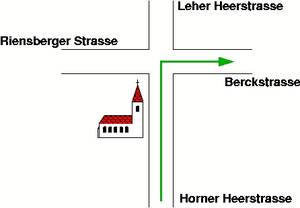Cognitive OpenLS
OpenLS is a trademark of the Open Geospatial Consortium.
Research on wayfinding and route directions in psychology, linguistics, and cognitive science provides ample evidence for principles of good route directions. By analyzing human route directions those principles can be extracted that are most successful, in opposition to simply mimic human route direction. In this report we combine existing approaches and our own research. We identified the following three principles that we consider essential for cognitively ergonomic route directions:
- Making direction concepts more precise:
Depending on the spatial structure of a decision point, describing the action to be performed may differ. For example, a change in direction usually described as "veer right" might turn to "fork right" given that the road ahead forks to the left and right (i.e. there are two possible branches to take, one heading off to the left, one to the right at approximately 45 degrees). - References to landmarks:
Landmarks are crucial for good route directions. They are used, among others, to identify decision points, to link actions to be performed to decision points, and to provide confirmation information that the correct route is still followed. - Subsuming route directions:
Subsuming several directions for individual decision points into one higher order direction covering a sequence of decision points with a single instruction is the third important principle of cognitive ergonomic route directions. Examples of instructions employing this spatial chunking are "turn left at the third intersection" and "follow the river until the gas station."

These principles need to be transformed into an adequate data structure to be able to represent the required information for automatically generating cognitively ergonomic route directions. With the Navigation Service the OpenLS specification developed by the Open Geospatial Consortium offers exactly the functionality required for this purpose. This service provides a client with the data necessary to generate route directions.
We developed Cognitive OpenLS, a data structure that captures these principles, which is based on the OpenLS specification. It is defined as a XML schema that reflects the principles listed above. Cognitive OpenLS encompasses our other research, especially results of the theory of wayfinding choremes and of the model for context-specific route directions.
Main publications:
Alexander Klippel, Stefan Hansen, Kai-Florian Richter, Stephan Winter (2009). Urban Granularities - A Data Structure for Cognitively Ergonomic Route Directions. In GeoInformatica (Volume 13 , Number 2, pp. 223-247).
Stefan Hansen, Kai-Florian Richter, Alexander Klippel (2006). Landmarks in OpenLS - A Data Structure for Cognitive Ergonomic Route Directions. In M. Raubal, H. Miller, A. U. Frank, M. F. Goodchild (Eds.), Geographic Information Science - Fourth International Conference, GIScience 2006, pp. 128-144. Springer, Berlin.
Stefan Hansen, Alexander Klippel, Kai-Florian Richter (2006). Cognitive OpenLS Specification. SFB/TR 8 Spatial Cognition. Technical report No. 012-10/2006.




